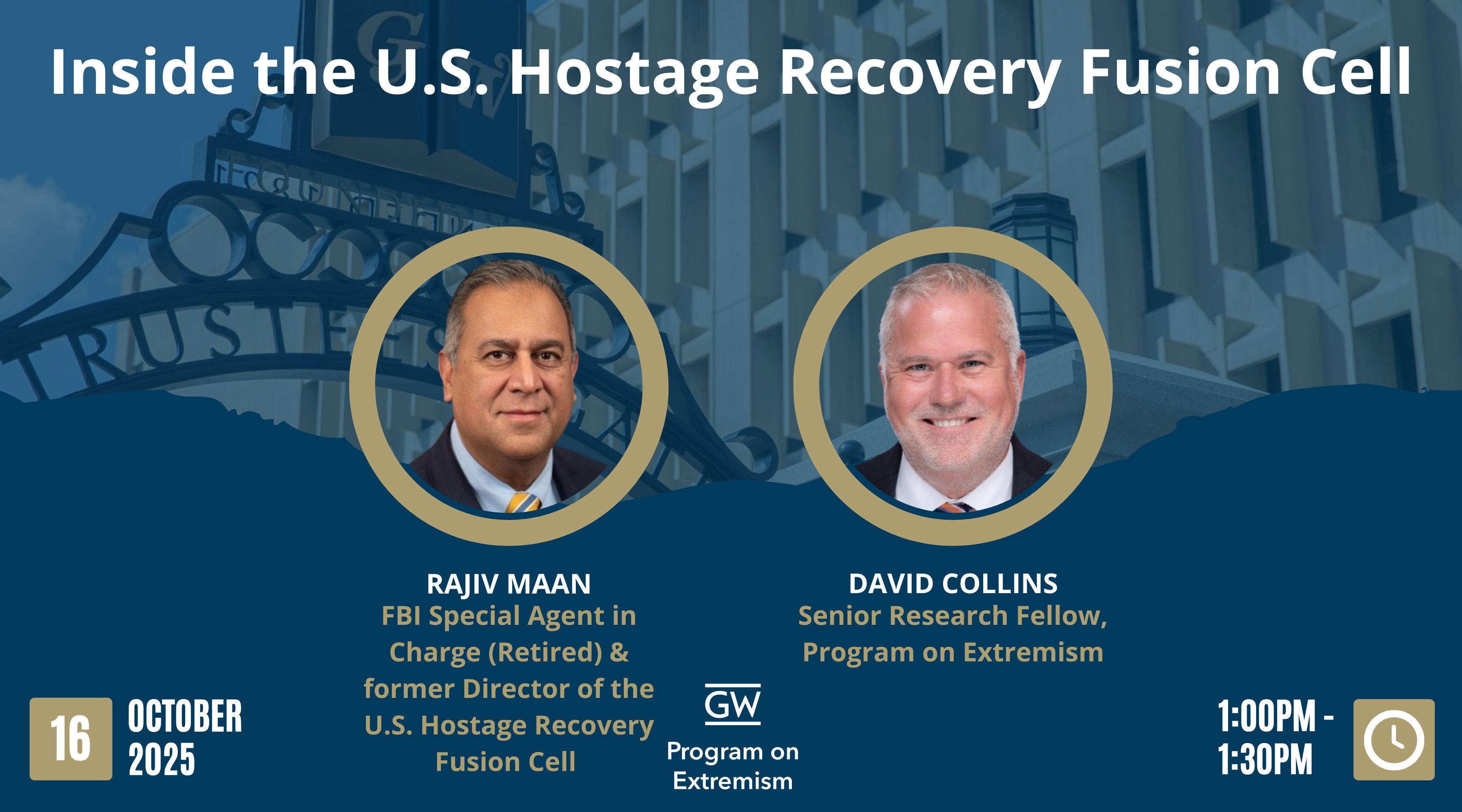Inside the U.S. Hostage Recovery Fusion Cell

The U.S. Hostage Recovery Fusion Cell was established in 2015 to unify the government’s voice and coordinate efforts to bring kidnapped U.S. citizens home. Since its inception, the Fusion Cell has evolved and expanded its mission to take a more proactive role in preventing hostage situations and protecting Americans abroad. This session, led by the recently retired FBI Los Angeles Special Agent in Charge and former Director of the U.S. Hostage Recovery Fusion Cell during and after the October 7, 2023, attacks in Israel, Rajiv Maan, provided an inside look at the Cell’s behind-the-scenes efforts to safely return all Americans held captive. The discussion was moderated by Senior Research Fellow David Collins.
The George Washington University's Program on Extremism hosted a virtual conversation with Rajiv Maan, a recently retired FBI Special Agent in Charge from the Los Angeles field office. The event was moderated by Senior Research Fellow David Collins. The discussion opened with Maan outlining his 30-year career in law enforcement, beginning in 1994 as a police officer in Northern California before joining the California Department of Justice's Bureau of Narcotic Enforcement. He described how the September 11 attacks fundamentally changed his career trajectory, prompting him to join the FBI in counterterrorism.
In September 2023, he became director of the Hostage Recovery Fusion Cell, a position he held for approximately two years before returning to Los Angeles in January 2025 as Special Agent in Charge for the counterintelligence and cyber program. Maan explained that the Hostage Recovery Fusion Cell, established in 2015, is an interagency entity comprising members from the Department of Defense, Department of State, Department of Justice, and Treasury.
The HRFC's core mission includes case coordination, recommending hostage recovery strategies to the president through the National Security Council, operational oversight, and coordinating intelligence gathering across all agencies. Maan emphasized that intelligence often arrives fragmented, requiring the cell to synthesize information into a coherent picture for the U.S. government - a process far removed from cinematic depictions.
The cell also maintains direct family engagement, ensuring families receive timely information and coordinating their meetings with the White House and other officials, as well as conducts after-action reviews following each case to capture lessons learned. Just weeks after Maan assumed the directorship, the October 7, 2023 Hamas attack on Israel occurred. He explained that the situation presented immediate obstacles: the hostages were held overseas in an active war zone where the United States was not militarily present, they were dual U.S.-Israeli citizens giving Israel a direct stake in their fate, and the FBI team prepared to deploy could not enter the theater.
Despite these challenges, both presidential administrations provided direct involvement, and the HRFC worked closely with Israeli counterparts through information sharing and intelligence analysis. Maan detailed the operational challenges, noting that hostage takers controlled the situation with captives held in unknown tunnel locations and moved frequently among three different groups: Hamas, Palestinian Islamic Jihad, and other factions. The cell faced limited information and bad-faith actors disseminating misinformation, creating tremendous emotional distress for families who felt nothing was being done quickly enough. He emphasized that every lead, regardless of veracity, had to be pursued, placing families on a continuous emotional roller coaster.
In response to questions, Maan addressed the HRFC's family engagement model, explaining that families have direct access to the family engagement team at any time and can request meetings with senior officials. The cell also partners with NGOs to provide support beyond government services. He confirmed that the HRFC collaborates closely with the State Department to issue warnings, conduct threat briefings for groups with members in high-risk areas, and run tabletop exercises with larger companies to prepare employees and establish expectations in case of kidnapping events.
Maan acknowledged that some U.S. citizens have been kidnapped multiple times, noting that while the HRFC's mission is to recover hostages regardless of circumstance, policy decisions rest with policymakers. Looking ahead, he described emerging initiatives including a "multi-fuse response" program to coordinate with allied nations who may have military or diplomatic footprints in regions where U.S. citizens are taken hostage, and emphasized that the cell continuously researches emerging groups and monitors trends in hostage-taking.

